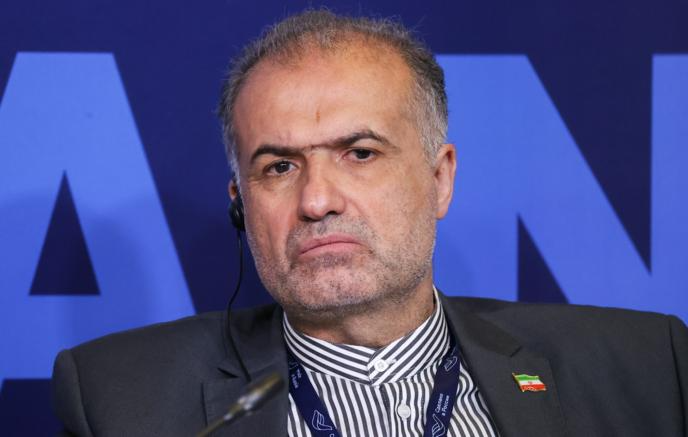|
|
TODAY.AZ / Arts & Entertainment
Rasim Aliyev: In memory of immortal grandee
25 November 2021 [13:31] - TODAY.AZ

By Azernews
By Orkhan Amashov
Architect Rasim Aliyev was a giant of a man, a larger-than-life personality whose innate talent was too immense to confine him to one single realm of human creativity. He was a figure who defined the age in which he lived, and his recent death marked the end of an epoch in the history of Azerbaijani architecture of which he was a revered patriarch.
As an architect, he combined two essential parts. He was a constructor who excelled at majestically bringing essential units into one holistic entity with an application of strict rationalism, yet the second side of his personality embodied a talented painter, who generated a vast array of new ideas feeding the soul of his art. A fine balance of these two components is essential to the makings of a great artist, and in Rasim Aliyev's person, they were in equal harmony.
Rasim Aliyev was born to be an architect. An aptitude for arts ran in the family. His father, academician Hasan Aliyev, loved to paint in his youth, whereas his uncle Huseyn Aliyev was a professional painter. It was his other uncle, Heydar Aliyev, who studied architecture at university, that had an undeniable influence on his life-defining choice. In fact, one may say Rasim Aliyev's rise as an architect was the realisation of accumulated creative genius within two generations of Aliyevs.
One of the brightest prodigies of his time, young Rasim was ready to take on challenges, and his first significant test came when, in accordance with the plan to redesign certain squares in Moscow by architects from the Union Republics, Taganskaya Square was allocated to the Azerbaijan SSR. Three young architects, including Rasim Aliyev, were called on to accomplish the task. The project was successfully completed and approved by the Central Committee but, due to an obscure and poorly understood set of reasons, the idea was later archived and never brought back. Young Rasim was brave enough to accept the challenge and worked flat out and round the clock to play his role in the grand project, yet when he heard that the plan was no longer underway, he remained indefatigable and braced himself for a new challenge.
Rasim Aliyev was a man of free spirit. As Anar, a famous Azerbaijani writer wrote in his foreword to "Rasim Aliyev: Memories" authored by Salim Babullaoghlu, the distinguished architect's "proud self-esteem did not accept any custody". He was a man who used to say what he believed to be right. Rasim Aliyev quickly found that his outlook and views on architecture were incompatible with official Soviet ideology, and he stated that "an architect could not reveal his creativity once being stuck in a standard project". He believed that the primitiveness offered in lieu of "Stalinist decoration" under Krushchev was alien to the true spirit of art.
As an architect, Rasim Aliyev found the artificial transformation of old structures into a "national style", by means of the application of various ornaments and motifs, to be a hopeless task. One of the modern examples of Baku's architecture, “Guest House", built on the basis of Rasim Aliyev's project, exemplifies his artistic vision. The building is a true adaptation of the Azerbaijani national style, incorporating the achievements of world architecture. Located in the midst of beautiful scenery and graced with pure proportional lines, the "Guest House" is a piece of art to be relished by posterity.
The building of the Azerbaijani embassy in Ankara, renowned for its compact architectural solution designed to suit the purpose of diplomatic functionality, is another example of Rasim Aliyev's genius. While designing Huseyn Javid's mausoleum in Nakhchivan, the architect managed to achieve the uniquely complex task of creating a new piece of art without being disloyal to the heritage ingrained in classical monuments such as the Momina Khatun Mausoleum and the tomb of Yusif Ibn Kuseyir, created by great Abubakr Ajami.
Rasim Aliyev was a visionary man, who excelled as an urban planner and town builder. He had a conceptual view for Baku, based on the idea that a city should have its own unique soul, embodied in its architecturally harmonious core. The harmony of the inner sanctum should be projected into a wider city, creating an ensemble of building units coalescing into oneness. He took an active part in the restoration of Bukhara and Multani caravansaries in "Ichari shahar" (Old City), the house of poet and painter Natavan in Shusha, buildings in Guba and the Palace of the Shaki Khans, amongst others.
During his tenures as deputy chief architect and then chief architect of Baku, he successfully oversaw the gradual expansion of the city and led the process of designing many micro-districts in Baku and Ahmadli settlement. The detailed plan for the reconstruction of "Ichari shahar" was developed with his participation.
In addition to being a great architect, Rasim Aliyev was a consummate connoisseur of jazz and a mugham aficionado. Those who were privileged to know him in person recall that he was noble in demeanour, yet very grounded. He was a friend to be relied upon in times of need. Always tastefully and elegantly dressed, he was a gentleman of impeccable taste.
Having found himself in front of gargantuan tasks on numerous occasions, he sometimes might have appeared to be wistful or melancholic, yet his acquaintances recall his unbridled enthusiasm and spirit.
May the soul of the Great Man rest in peace amidst the glorious cities of heaven.
URL: http://www.today.az/news/entertainment/212598.html
 Print version
Print version
Connect with us. Get latest news and updates.
See Also
- 21 January 2026 [15:19]
Nizami Cinema Center premieres historical-documentary animation - 21 January 2026 [14:43]
Emin Afandiyev's film awarded at Dhaka Int'l Film Festival - 21 January 2026 [13:02]
Int'l Mugham Center commemorates Black January victims - 20 January 2026 [15:48]
Presidential Library commemorates victims of January Tragedy - 20 January 2026 [15:10]
Composers' Union pays tribute to victims of Black January - 20 January 2026 [12:03]
YARAT launches third season of film school - 20 January 2026 [11:39]
Educational institutions mark National Mourning Day - 20 January 2026 [10:20]
Baku to hold concert honoring victims of Black January - 19 January 2026 [15:06]
Etibar Asadli infuses Middle Eastern rhythms in latest album - 19 January 2026 [12:58]
Leyla Aliyeva visits MESOB Public Service Center in Ethiopia
Most Popular
 Trump reiterates claim of 'Russian threat' over Greenland, saying 'it is time'
Trump reiterates claim of 'Russian threat' over Greenland, saying 'it is time'
 Why sanctions against Iran are hitting so hard ...Of Armenia
Why sanctions against Iran are hitting so hard ...Of Armenia
 History repeats itself, but Black January won't happen again
History repeats itself, but Black January won't happen again
 Iran links proposed Western sanctions to Israel, draws russian criticism of Merz
Iran links proposed Western sanctions to Israel, draws russian criticism of Merz
 Where can you find doctors who could cure Dugin?
Where can you find doctors who could cure Dugin?
 Leyla Aliyeva visits MESOB Public Service Center in Ethiopia
Leyla Aliyeva visits MESOB Public Service Center in Ethiopia
 Former Israeli Ambassador to Azerbaijan Eitan Naeh dies at 63
Former Israeli Ambassador to Azerbaijan Eitan Naeh dies at 63
